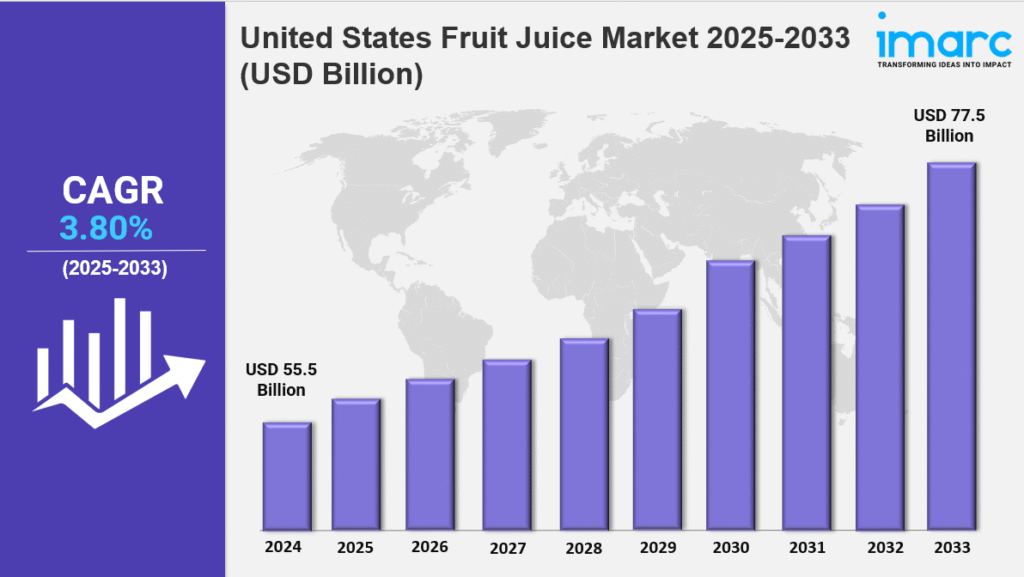IMARC Group has recently released a new research study titled “United States Fruit Juice Market Size, Share, Trends and Forecast by Product Type, Flavor, Distribution Channel, and Region, 2025-2033,” which offers a detailed analysis of the market drivers, segmentation, growth opportunities, trends, and competitive landscape to understand the current and future market scenarios.
United States Fruit Juice Market Overview
The United States fruit juice market size was valued at USD 55.5 Billion in 2024. Looking forward, IMARC Group estimates the market to reach USD 77.5 Billion by 2033, exhibiting a CAGR of 3.80% from 2025-2033.
Market Size and Growth
Base Year: 2024
Forecast Years: 2025-2033
Historical Years: 2019-2024
Market Size in 2024: USD 55.5 Billion
Market Forecast in 2033: USD 77.5 Billion
Market Growth Rate 2025-2033: 3.80%
Request for a sample copy of the report: https://www.imarcgroup.com/united-states-fruit-juice-market/requestsample
Key Market Highlights:
✔️ Rising consumer focus on health and wellness is fueling demand for natural, no-added-sugar fruit juices
✔️ Strong market push toward functional juices with added vitamins, antioxidants, and immunity-boosting ingredients
✔️ Growing innovation in cold-pressed, organic, and exotic fruit blends to meet premium segment demand
United States Fruit Juice Market Trends
The United States Fruit Juice Market is experiencing a significant shift as consumers increasingly prioritize wellness over sugar content. With growing demand for cleaner, healthier beverages, cold-pressed juices, organic blends, and vegetable-based options are rising in popularity. This trend is expanding the United States Fruit Juice Market Size, as juice companies adapt to meet modern nutritional standards and changing lifestyles.
Top players such as Tropicana, Suja, Bolthouse Farms, and Naked Juice are leading the charge, reformulating products with reduced sugar, no artificial additives, and added functional ingredients like probiotics, antioxidants, and immune-supporting vitamins. These new formulations are turning juice into a daily wellness solution rather than just an occasional treat.
Striking a Balance Between Premium and Affordable
While the demand for premium wellness beverages continues, price sensitivity remains high amid ongoing inflation. To stay competitive, companies in the United States Fruit Juice Market are offering a diverse range of products that cater to both high-end consumers and cost-conscious buyers.
As a result, mid-priced juice options are gaining traction and reshaping the United States Fruit Juice Market Share, even as luxury juice products maintain strong brand loyalty. This strategic balance is helping companies expand their customer base while navigating economic headwinds.
Following the surge in online shopping during the pandemic, many juice brands are now embracing an omnichannel approach. In 2024, companies like Ocean Spray and Simply Beverages leveraged e-commerce platforms, mobile apps, and in-store promotions to connect with consumers across multiple touchpoints.
Convenience stores and health-focused outlets have outpaced traditional supermarkets, offering curated selections and personalized loyalty programs that attract repeat buyers. These omnichannel strategies are driving stronger brand visibility in an increasingly crowded United States Fruit Juice Market.
Sustainability and Ethical Sourcing Fuel Brand Loyalty
Today’s consumers expect more than just taste—they want ethical and environmentally responsible products. Sustainable packaging solutions, including compostable cartons and plant-based bottles, are now industry standards. Leading brands such as Suja Juice and Bolthouse Farms have made sustainability a key pillar, strengthening their positions in the expanding United States Fruit Juice Market Size.
Certifications like USDA Organic, Fair Trade, and Non-GMO Project Verified now influence nearly one-third of juice purchases. These labels reflect consumer demand for transparency, fair labor practices, and environmentally sound agriculture—all of which are shaping long-term United States Fruit Juice Market Growth.
In response to global supply chain pressures, many juice producers are prioritizing local sourcing from American-grown fruits such as apples, cranberries, and berries. These efforts, backed by USDA grants and sustainability initiatives, help reduce dependence on imports and improve supply stability. Meanwhile, tech investments in circular economy systems, smart irrigation, and bottle-to-bottle recycling are enhancing both environmental performance and operational efficiency.
Innovation and Transparency Set the Tone for Future Growth
Emerging brands and private labels are disrupting the market with clean-label, minimal-ingredient juices targeting Gen Z and health-conscious millennials. Subscription models, seasonal blends, and social media-driven campaigns are redefining engagement, while blockchain tools are being tested to ensure transparent sourcing from farm to shelf.
Larger companies, including PepsiCo (which owns Tropicana and Naked), are acquiring niche startups to diversify their portfolios. Simultaneously, private equity firms are betting on new shelf-stable technologies that promise convenience without compromising on nutrition.
The United States Fruit Juice Market Share continues to evolve toward a model that blends health, sustainability, and personalization. While sugar concerns may flatten volume growth, the market’s value is climbing—fueled by premium products, ethical practices, and strong consumer engagement. As the juice aisle transforms, it reflects a broader movement toward mindful consumption and purposeful innovation.
United States Fruit Juice Market Segmentation:
The market report segments the market based on product type, distribution channel, and region:
Analysis by Product Type:
- 100% Fruit Juice
- Nectars
- Juice Drinks
- Concentrates
- Powdered Juice
- Others
Analysis by Flavor:
- Orange
- Apple
- Mango
- Mixed Fruit
- Others
Analysis by Distribution Channel:
- Supermarkets and Hypermarkets
- Convenience Stores
- Specialty Food Stores
- Online Retail
- Others
Regional Analysis:
- Northeast
- Midwest
- South
- West
Ask Analyst & Browse Full Report with TOC & List of Figures: https://www.imarcgroup.com/request?type=report&id=20153&flag=C
Competitive Landscape:
The market research report offers an in-depth analysis of the competitive landscape, covering market structure, key player positioning, top winning strategies, a competitive dashboard, and a company evaluation quadrant. Additionally, detailed profiles of all major companies are included.
Key Highlights of the Report
1. Market Performance (2019-2024)
2. Market Outlook (2025-2033)
3. COVID-19 Impact on the Market
4. Porter’s Five Forces Analysis
5. Strategic Recommendations
6. Historical, Current and Future Market Trends
7. Market Drivers and Success Factors
8. SWOT Analysis
9. Structure of the Market
10. Value Chain Analysis
11. Comprehensive Mapping of the Competitive Landscape
About Us:
IMARC Group is a leading market research company that offers management strategy and market research worldwide. We partner with clients in all sectors and regions to identify their highest-value opportunities, address their most critical challenges, and transform their businesses.
IMARC’s information products include major market, scientific, economic and technological developments for business leaders in pharmaceutical, industrial, and high technology organizations. Market forecasts and industry analysis for biotechnology, advanced materials, pharmaceuticals, food and beverage, travel and tourism, nanotechnology and novel processing methods are at the top of the company’s expertise.
Contact Us:
IMARC Group
134 N 4th St. Brooklyn, NY 11249, USA
Email: sales@imarcgroup.com
Tel No:(D) +91-120-433-0800
United States: +1 201971-6302









